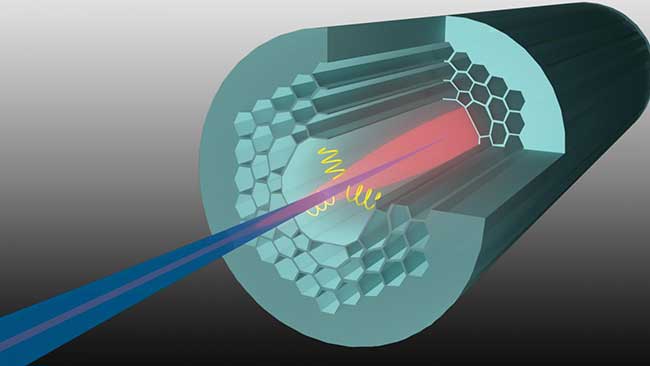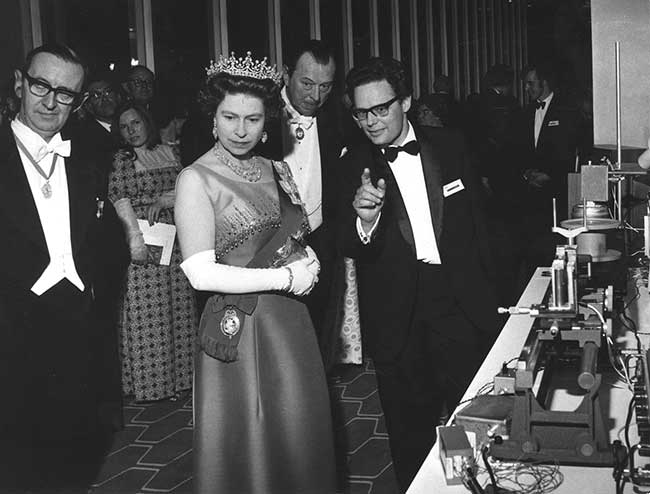Fiber optics components and systems are seeing application in an increasing number of technologies, products and research initiatives. From its modest beginnings to present-day advancements, the field of fiber optics is poised to further revolutionize communication networks, optical devices and more.
The basis of optical communications systems, fiber optics uses thin, flexible glass or plastic fibers as wave guides, or “light pipes,” to channel light from one location to another. This concept has been around since the late 19th century, when scientist William Wheeling patented the “piping light” method of light transfer. Alexander Graham Bell later developed the photophone, an optical voice transmission system that used free-space light to carry the human voice from one location another about 200 meters away.
These inventions kick-started the field of fiber optics, but it wasn’t until the mid-20th century that it began to take its modern shape. Today, such systems are finding strength in military, industrial, commercial and data applications, among others.

Optical cable connections.
A communications revolution
From the first generation systems to the most current, fiber optics has revolutionized the way people communicate in today’s world, from telephone systems to the Internet to media displays. And while it is still evolving, fiber optics has helped to advance research in various areas of the photonics industry, in products including lasers.
IPG Photonics Corp., headquartered in Oxford, Mass., recently developed an innovative fiber optics-based laser system, which was honored in 2015 with a Prism Award for Photonics Innovation in the industrial lasers category. The 500-W, quasi-CW, green, single-mode fiber laser (GLPN-500-R) is suited for industrial applications ranging from copper welding to solar cell manufacturing, in addition to applications in defense and security, materials processing and laser light shows.
“The laser provides pulse energies similar to [its] predecessor, 100-W green laser, a few microjoules, but at a higher repetition rate,” said Alexei Markevitch, market development manager at IPG. “Therefore, it can be used in all applications where the earlier lower power laser has been qualified, but at a five times higher throughput.”
He added that the laser’s combination of single-mode beam quality, short wavelength, short pulse duration and higher power allows exploration of new applications. A year after the product’s Prism Award win, IPG has continued to enhance its GLPN-500-R. The laser’s architecture and components underwent continued optimization, according to the company, resulting in a significant reduction in form factor.
“The end-user rack-mounted version has been reduced in size by more than 30 percent, and a super compact OEM laser module has been released,” Markevitch said. “The laser heads in operation have acquired many thousands of hours, proving robust operation of the doubling crystals and optics at unprecedented high powers.”
Now, IPG’s R&D team is working on customized versions of the laser, with features specific to applications and customers, i.e., linewidth, modulation capabilities, control features, etc.
Fiber optics is seeing innovation in other research, as well, including at the Max Planck Institute for the Science of Light (MPL) in Erlangen, Germany. There, researchers have demonstrated that laser light can be used to manipulate a glass optical fiber that is tapered to a sharp point called a nanospike, which is smaller than a speck of dust, in the middle of an optical fiber with a hollow core. In a paper published in OSA’s Optica, they reported that optical forces cause the nanospike to self-align at the center of the hollow core, trapping it stronger at the core center as the laser power increases.

Robotics has benefited from advances in lasers, optical fiber, image sensors and optical sensors. Courtesy of The Optical Society (OSA), Optica.
To create the nanospike, an ordinary single-mode glass optical fiber about 100 μm in diameter was heated so that it could be stretched to form a tapered portion, and then the fiber’s tip was etched with hydrochloric acid to create a nanospike around 100 nm in diameter,
and less than 1 mm long. In their work, the researchers inserted the nanospike into the hollow-core fiber. A high-power 1064-nm laser beam was then launched into the single-mode fiber to create the optical trap. When the laser light entered the tapered portion of the fiber, the researchers said it began to spread out beyond the nanospike into the empty space inside the hollow core fiber. As the taper got smaller, the light began to sense the boundary of the larger fiber core, causing the light to reflect inward toward the tapered fiber. This reflected light exerted a mechanical force on the nanospike, forming an optical trap.
“Launching very high power laser light into an optical fiber, especially a hollow-core fiber, can be very difficult and usually requires extensive electronics and optics to maintain alignment,” said Philip Russell, director at MPL, and leader of the research team.
This system offers a completely new method of coupling light into hollow-core fibers with the unique features of self-stabilization and self-alignment, without the need for extensive electronics and optics, said Shangran Xie, a postdoctoral fellow in the Russell Division at MPL, and first author of the Optica paper.
“The optical trapping mechanism in our system is also different from conventional optical tweezers, as it arises from the optomechanical interaction between the nanospike and HC-PCF [hollow-core photonic crystal fiber],” he said. “The measured optical trapping force acting on the nanospike is one order of magnitude stronger than conventional optical tweezers. This new trapping mechanism may find future applications on stably optical trapping of complex shaped objects, [such as] biological cells and DNA.”
Xie added that, at this point, the work is progressing well. He and fellow researchers hope to further apply this nanospike technique to other hollow-core fiber systems, including gas- or liquid-filled HC-PCF. This could lead to applications such as UV light generation and biological cell trapping.
Looking to the future
Many envision a communication network that is “completely in the optical domain, giving rise to an all-optical communication network,” according to the paper by Idachaba et al., which also predicts that all signals could be processed in the optical domain, without any form of electrical manipulation. The researchers note a cost-saving benefit of all-optical networks: There would be no need to replace related electronics when the data rate increases, “since all signal processing and routing occurs in the optical domain.”
Improvements in laser technology are also possible, including the extension of existing semiconductor lasers to a wider variety of lasing wavelengths; shorter wavelength lasers with very high output powers are of interest in some high density optical applications, the paper states. Also cited for future growth are technologies such as optical amplification and optical transmitters/receivers.
As such technologies and applications expand, so, too, should the workforce. Programs like Tukwila, Wash.-based The Light Brigade, a fiber optics training subsidiary of infrastructure specialist AFL, are emerging to help build the staff. The Light Brigade is working with the NeST Institute of Fiber Optic Technology Pvt. Ltd. of Kerala, India, to introduce the Amal Jyothi NeST Center for Fiber Optic Technology training program. It aims to provide leading fiber optics training solutions to meet the high demand for skilled fiber optics technicians in India. Students who complete the training can earn an ETA (Electronic Technicians Association International) Fiber Optic Installer certification, and course graduates receive job placement assistance across India and the Middle East.
“This collaboration with the [Amal Jyothi] engineering college will provide more opportunities for people to be trained, and ultimately employed, as fiber optic field technicians,” said Larry Johnson, founder and director of The Light Brigade.
Also evolving is the fiber optics market. Production is expected to reach record levels within the next few years, namely in the Asia-Pacific region, Europe and North America, according to a 2014 report, “Fiber Optics Market Worth $3 Billion by 2019,” by MarketsandMarkets. The Asia-Pacific fiber optics market is growing with “government directives intended to increase and encourage national broadband applications,” and is expected to see the fastest growth rate by 2019.
Telecom and broadband take the top positions in the fiber optics market, as stated in the report, with an approximately 55 percent share by value in 2013. These applications, in addition to private data networks, and use in the oil and gas industries, are expected to see the fastest growth rate in this market by 2019.
Guiding light: An Early History of Fiber Optics
Fiber optics’ roots can be traced back to the late 1800s. In 1870, Irish physicist John Tyndall demonstrated that light could be guided to follow a specific path. In a stream of water that flowed downward from one container to another, he directed a beam of sunlight to the same path as the water. Tyndall’s experiments demonstrated total internal reflection, which means optical rays are unable to break from the material in which they are traveling.
Experiments several years later by scientist William Wheeling expanded on Tyndall’s work. He patented a method of light transfer called “piping light.” Using several mirrored pipes that extended from a single light source, the light could be sent to different rooms in a way similar to water plumbing in a building. These findings, along with Tyndall’s, formed the basis of modern fiber optics communications networks.
1870 Scientist John Tyndall’s experiments with water and beams of light mark the first research of the guided transmission of light.
1880 Scientist William Wheeling patents a method of light transfer called “piping light.”
Alexander Graham Bell develops the photophone, an optical voice transmission system.
A Brief Modern Fiber Optics Timeline
1957 Basil Hirschowitz, Larry Curtis and C. Wilbur Peters, all members of the medical school faculty at the University
of Michigan, create the first fiber optics endoscope.
1961 American Optical Co. employees Elias Snitzer and Will Hicks created and demonstrated the first optical glass fiber laser. The National Academy of Engineering (NAE) affirms that the fiber’s core was small enough for the light to follow a single path. Snitzer later developed the first optical fiber amplifier, and was also involved in the development of the first fiber optics laser amplifier.

Courtesy of Philip Russell/Max Planck Institute for the Science of Light.
1970 Donald Keck, Peter Schultz and Robert Maurer, all scientists at Corning Glass Works, created the first glass optical fibers that were touted as “the purest glass ever made,” according to NAE. It was composed of fused silica from the vapor phase, and exhibited light loss of less than 20 dB/km (1 percent of light remains after traveling 1 km). This and other similar developments helped bring fiber optics components and systems toward commercialization.
1977 A 1.5-mile underground fiber optics transmission system links Illinois Bell central offices and customers across three buildings.

Murray Ramsay demonstrates video transmission over optical fibers to Queen Elizabeth II during a physics exhibition in London in 1971. It showed the technology’s potential to revolutionize telecommunications. Courtesy of Institute of Engineering and Technology Archives.
1980 AT&T announces that it will install fiber optics cable linking major cities between Boston and Washington, D.C.
1997 The Fiber Optic Link Around the Globe becomes the longest single-cable network in the world at 17,500 miles long.
2000 360Networks of Seattle completes the first fiber optics cable between the U.S. and Venezuela.
2012 Elias Snitzer, hailed the father of fiber lasers and fiber amplifiers, is honored posthumously by the Institute of Electrical and Electronics Engineers for his contributions to fiber optics technology and other photonics research.
To learn more about fiber optics technology, read “Fiber Optics: Understanding the Basics,” a Photonics Handbook article by OFS, Specialty Photonics Div.